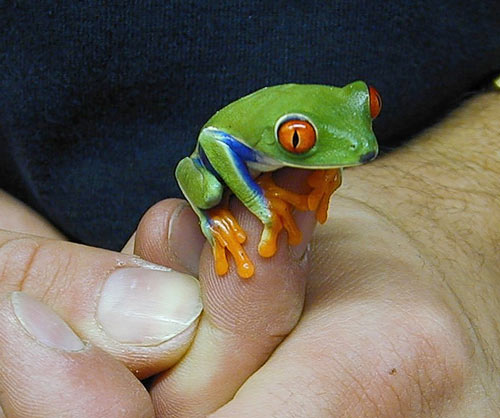The red eyes tree frogs
Some information about them
Author : David, created : 2004, last updated in April 2010
While working on The Frog 2, I've been looking for information and photos of red eyes tree frog. I found this creature very interesting. Here is my summary on the subject.
A new version of this article is available at DreamCraft's website.
Red eyes tree frogs are as small as a thumb and live in the jungles of Central America.
It's like if these frogs have been created for the character animators. They have a cartoon feel to them, with their big eyes and kind of a constant smile on their face. They're always climbing to branches, for which reason they are also called monkey frogs. Their face expressions are almsot human.
The Red Eyed Tree Frogs are known foremost for their huge, bright red eyes, a possible adapation to nocturnality or the central component of a defensive strategy called startle coloration. Their dorsal area is usually a neon-like shade of green, but can sometimes range from blue to yellow in coloring. The sides are light blue with cream to yellow colored stripes. The upper legs are bright blue, and the feet are a bright orange or red. They have large, specially developed suction cup toe pads, which allow them to attach to leaves, branches, and the sides of trees.
Some believe that the bright, red eyes of this frog act as a form of defense, termed "startle coloration". Red-eyed tree frogs are nocturnal and rest during the day. If a predator were to happen upon him, the frog would awaken, and its eyes would pop open abruptly. The sudden brightness of their red eyes might startle the predator enough to give the frog the mere seconds necessary to jump to safety.
They are excellent climbers and, as mentioned before, have suction-cup toes that help them attach themselves to the underside of leaves, where they rest during the day. They can also be found clinging to branches, tree trunks, and leaves throughout their habitat. Like any other frogs, they are able to swim.
This frog symbolizes the rain forest in which he resides. Global warming, deforestation, climatic and atmospheric changes, wetland drainage, and pollution have caused dramatic declines in the amphibian population in, and among the rainforests of Central and South America. If the rainforest disappears, this beautiful creature will no longer exist.
During my search for red eyes tree frogs, I came across this young frenchman's site, full of frogs : Aquaviva.
I asked the webmaster Greg for help as i wanted to see how a red eye tree frog moves.
Greg couldn't provide me with videos showing moving frogs, but he owned a red eyed tree frog,
and described the way they moved.
Greg said: "This frog does not move often. But when it does, it moves very slowly, kind of like a chameleon.
Its hands go back and forth on the surface it's walking on.
One hand can go forward 1 centimeter, then go backward half a centimeter, then go forward again.
It tries to mimic a leaf moving under the wind. This is a self protection, camouflage mechanism.
When it is afraid or feels threatened, it jumps. As a result, the zebra-striped flanks are displayed,
and this sight can frighten the aggressor.
That's how it moves".
Later, while working on the short, I let down realistic motions and decided to make a cartoon-like animation for the frog.
That's why Greg was astonished when I showed him the final result!
My thanks Greg for his precious help and photos. You ought to visit his site.
My friend David Hoskin liked the "frog 2" short so much that his family offered him a real frog of the same kind. Here's a video he sent me.
References :
http://www.discovery.com/.
Aquaviva.










